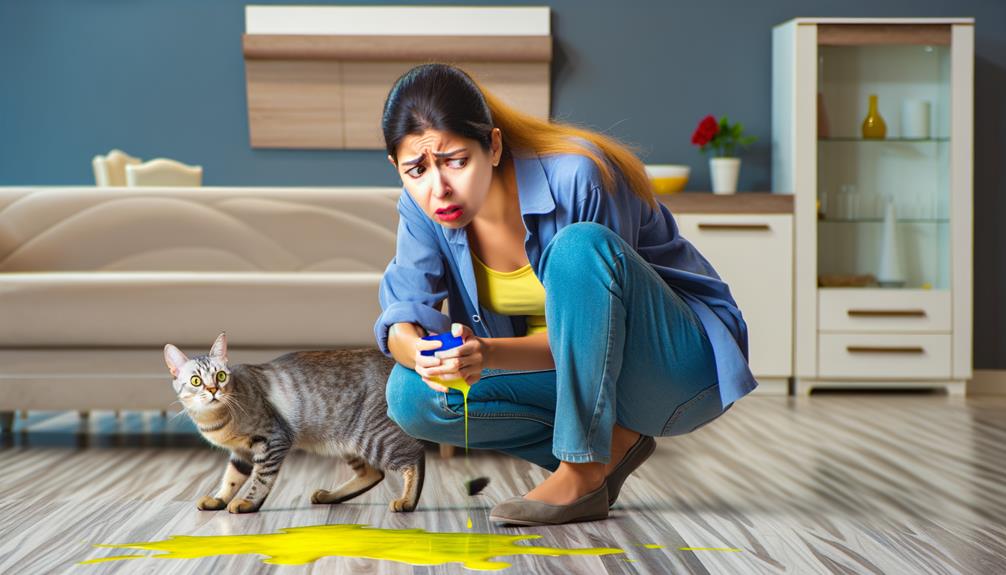You've just encountered something unexpected in your cat's vomit – a yellowish tint. Now, you're probably worried, wondering what could be the cause. Is it a simple upset stomach or something more serious like liver or gallbladder issues? The color, consistency, and frequency of your cat's vomit can be telling indicators of its health. But how do you interpret these signs correctly? And when is it time to rush to the vet? Let's dig into this issue, shedding light on potential causes and solutions for your cat's yellow vomit.
Understanding Cat Vomiting: The Basics
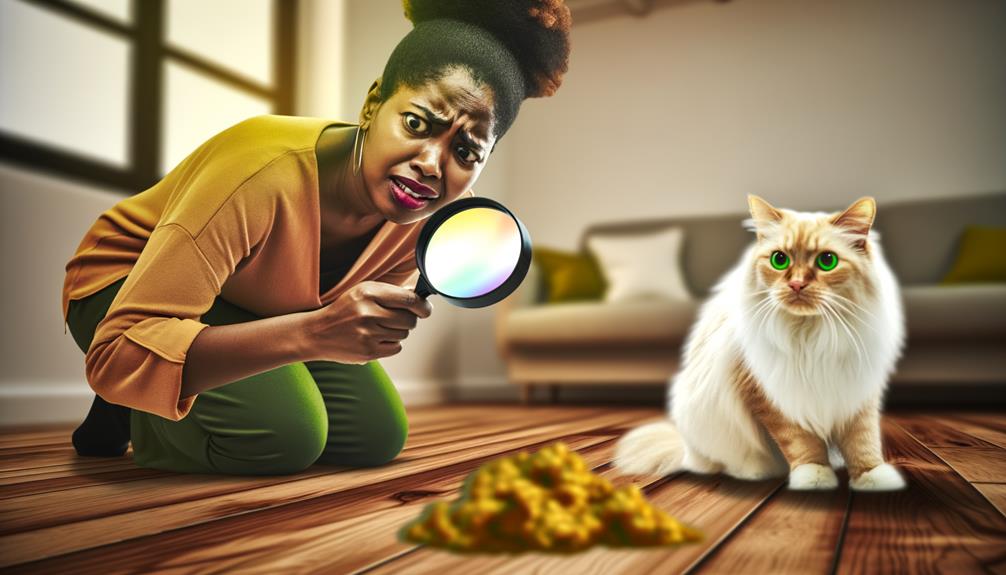
To get to the root of your cat's yellow vomit, it's essential to first understand the basics of cat vomiting. Vomiting reflexes are natural and play a crucial role in a cat's digestive process. When something doesn't agree with your furry friend's stomach, their body naturally expels it to prevent further harm.
Yet, this doesn't mean you should take it lightly. It's vital to observe your cat's behavior and ensure they're not vomiting frequently. Regular vomiting could indicate serious health issues, including digestive problems, infections, or food allergies.
Feline hydration also plays a significant role in vomiting. Like us, cats need water to maintain their health and wellness. Dehydration can often lead to vomiting, and in severe cases, it could turn their vomit yellow. So, keep an eye on their water intake. If you notice they're not drinking enough, or if their vomit is yellow, it's advisable to seek veterinary help immediately.
Normal Vs. Abnormal Vomit in Cats
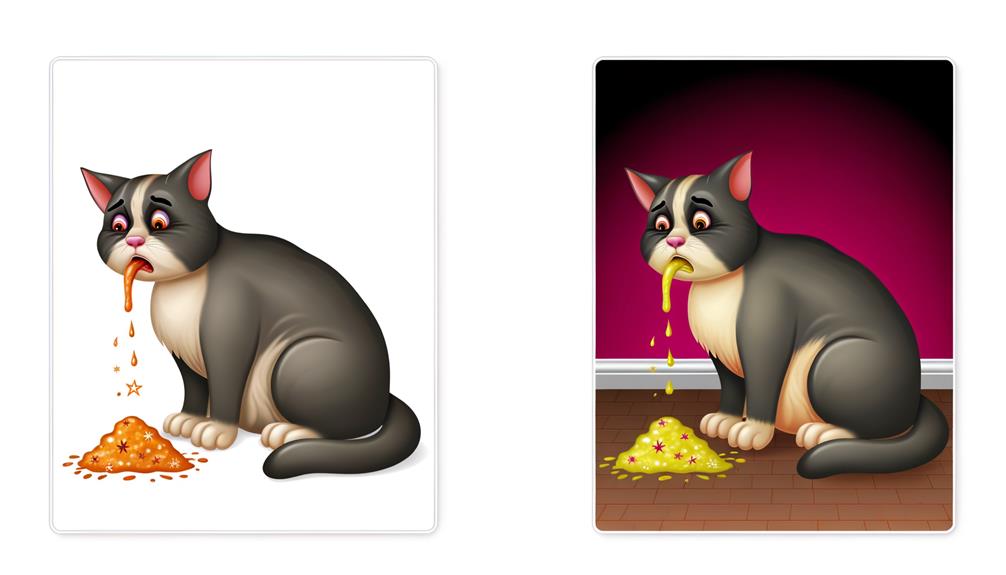
Let's now discuss how to distinguish between normal and abnormal cat vomit. By understanding what's typical, you'll be better equipped to recognize when something's off.
We'll also touch on what might cause your feline friend to vomit abnormally.
Identifying Normal Cat Vomit
Understanding the difference between normal and abnormal cat vomit can help you monitor your pet's health more effectively. Firstly, consider vomit consistency. Normal cat vomit might be semi-solid or liquid, and may contain undigested food. This is usually due to your pet eating too quickly or consuming something disagreeable.
Next, look at vomit frequency. An occasional upchuck, especially after meals, isn't a cause for concern. However, if your cat is vomiting frequently, this could be an indication of a more serious health issue.
Understanding Abnormal Cat Vomit
While normal cat vomit is often no cause for alarm, it's important to note the signs of abnormal cat vomit that may indicate underlying health problems. The vomit color significance can't be overlooked. Yellow vomit could point towards bile, suggesting problems with your cat's liver or gallbladder. Darker hues might mean your feline friend has ingested something harmful.
Hydration effects also play a role in the appearance of vomit. Dehydrated cats often produce vomit that's thicker and less liquid. Conversely, well-hydrated cats may vomit a more diluted substance. If you notice your cat throwing up frequently, particularly if the vomit is yellow or of an unusual consistency, it's an indication to consult with a vet, as this could be a symptom of a more serious health issue.
Causes of Abnormal Vomiting
Diving into the specifics, you should know that abnormal vomiting in cats can stem from a wide variety of causes, ranging from dietary missteps to serious illnesses. Vomit color significance is paramount in determining the underlying issue. For instance, yellow vomit often signifies bile, which could indicate a fasted state or a liver problem.
Vomiting frequency patterns also tell a tale. Occasional vomiting may be due to hairballs or overeating. However, frequent vomiting could hint at a serious condition such as kidney disease or cancer. Changes in your cat's vomit color or frequency should never be ignored. You're your cat's best advocate, so stay vigilant and consult a vet when you notice any abnormalities.
Possible Causes of Yellow Vomit
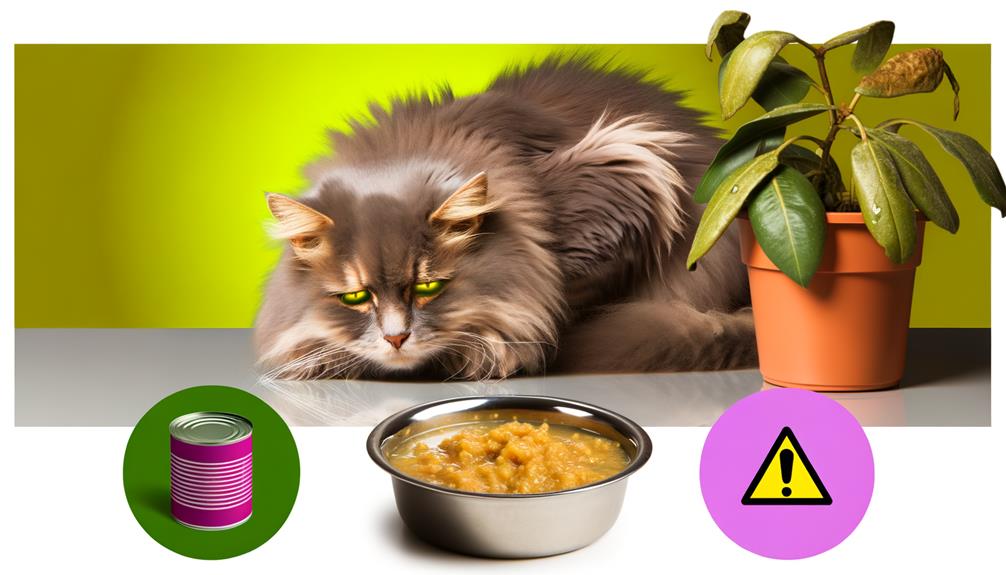
You might be wondering why your cat's vomit is yellow.
It could be due to a number of reasons, including dietary influences, underlying health disorders, or even the effects of certain medications.
Let's explore these possibilities to better understand what might be causing this unusual symptom in your feline friend.
Dietary Influences on Vomit
If your cat's diet isn't quite right, it could lead to yellow vomit, a common symptom of various digestive issues.
Now, let's break down how dietary influences can cause this:
- Food allergies: Just like humans, cats can suffer from food allergies. Consuming allergenic food can upset their stomach and lead to vomiting.
- Poison ingestion: Cats are curious creatures. If they ingest a toxic substance accidentally, they may vomit yellow as their body tries to expel the poison.
- Change in diet: A sudden change in your cat's diet can cause digestive upset, resulting in yellow vomit.
- Overeating: Overeating or eating too fast can also lead to vomiting.
Impact of Health Disorders
Apart from dietary factors, several health disorders could also be behind your cat's yellow vomit. Liver diseases impact your cat's ability to break down and eliminate toxins, leading to bile accumulation. This may result in yellowish vomit.
Keep an eye out for other symptoms, such as jaundice or weight loss, which could indicate liver disease. Kidney failure symptoms also include vomiting, often yellow in color due to the build-up of waste products in the blood. Other signs of kidney disease include increased thirst and urination, loss of appetite, or lethargy.
It's crucial to seek veterinary advice if you notice any of these symptoms. These conditions are serious, and early detection can vastly improve your cat's prognosis.
Effect of Medications
Administering certain medications to your cat can also lead to yellow vomit, as some drugs may irritate the stomach lining or interfere with the digestive process. Medication reactions are often the cause of this unexpected color change.
Now, let's discuss the potential issues:
- Prescription side effects: Some drugs, especially antibiotics or chemotherapy, may cause an upset stomach resulting in yellow vomit.
- Acid reflux: Medications can cause acid reflux, leading to yellowish vomit.
- Allergic reactions: Your cat might be allergic to certain drugs, causing an adverse reaction that includes vomiting.
- Overdosing: Giving your cat too much medication can lead to vomiting, and the vomit will likely be yellow due to bile.
Always monitor your cat's reaction to new medications and consult with your vet if you notice any changes.
Dietary Influence on Cat Vomit
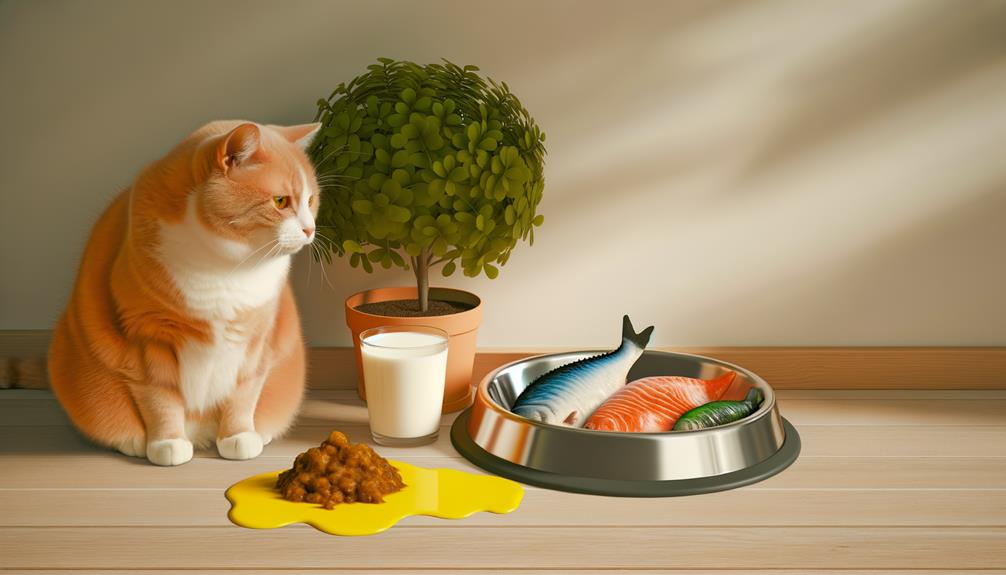
What your cat eats can significantly affect whether it vomits yellow bile or not. Food allergies, for example, can be a major culprit. If your feline friend has an allergy to a particular ingredient in their food, it may react adversely, leading to vomiting. You might notice the vomit is yellowish, a color that comes from bile, a digestive fluid.
Hydration status also plays a vital role. Cats, like humans, need to stay hydrated. If they're not drinking enough water, or if they're losing too much fluid through vomiting, they may become dehydrated. This can also cause them to vomit bile. Dehydration can make the bile more concentrated, leading to a darker, more noticeable yellow color.
Health Risks of Frequent Vomiting
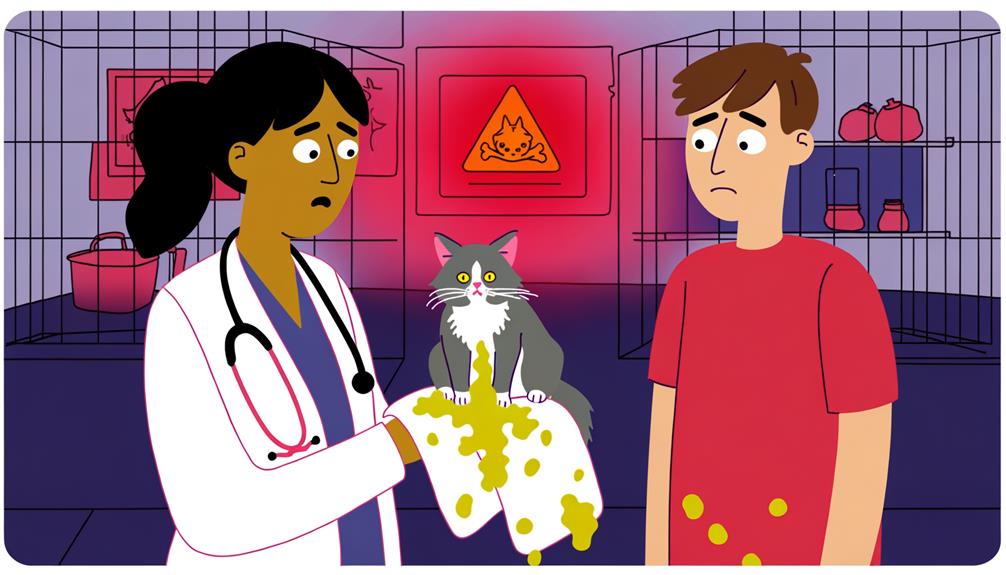
In the face of frequent vomiting, your cat's health may be at serious risk. This could be a sign of underlying issues that require immediate attention. You should be aware of the potential risks and dangers to your feline friend, which include:
- Dehydration dangers: Vomiting can cause your cat to lose fluids rapidly, leading to dehydration. This can result in lethargy, sunken eyes, and a lack of appetite.
- Electrolyte Imbalance: Along with fluids, your cat may also lose important electrolytes. This can lead to weakness, tremors, and in severe cases, seizures.
- Underlying allergies or intolerance: If your cat is vomiting frequently, it might be an indication of an underlying allergy or intolerance. This can range from certain foods to environmental factors.
- Damage to the esophagus: Chronic vomiting can lead to inflammation or even damage to the esophagus, which can make swallowing painful for your cat.
When to Consult a Veterinarian
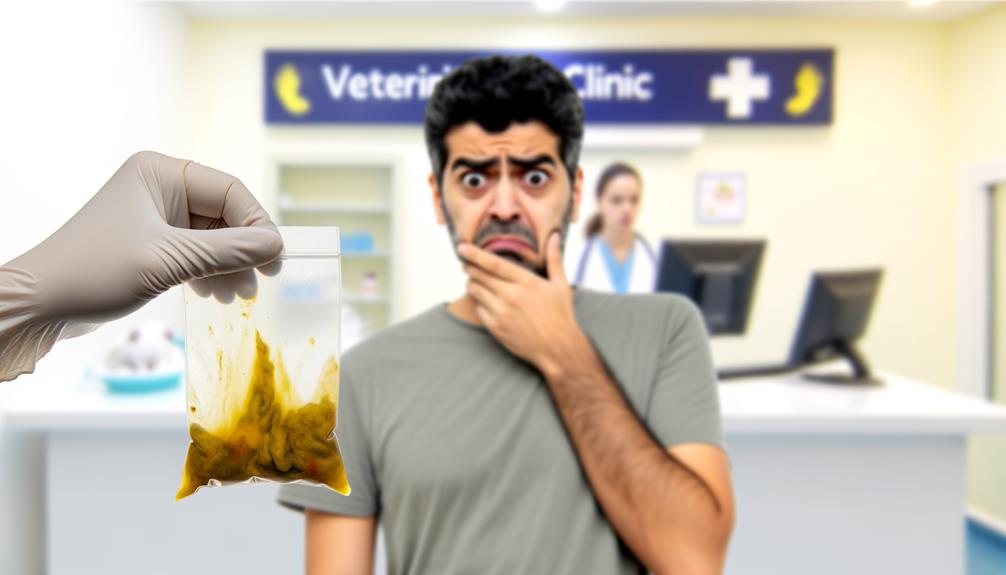
As a cat owner, you should consult a vet if your cat's vomiting becomes frequent or if you notice any changes in its behavior or physical condition. It's crucial to take note of these signs as they could indicate health complications that require immediate attention.
The vet consultation process is typically straightforward. It begins with you sharing your observations and concerns about your cat's health. The vet will then conduct a comprehensive exam to determine the cause of the symptoms. This might involve physical examination, laboratory tests, or imaging studies.
However, in some cases, your cat's condition might deteriorate rapidly, necessitating the use of emergency vet services. If your cat experiences severe lethargy, bloody vomit, or a sudden change in behavior, don't hesitate to seek immediate help. Emergency vet services are equipped to handle critical situations and can provide life-saving interventions.
Prevention and Home Care Tips
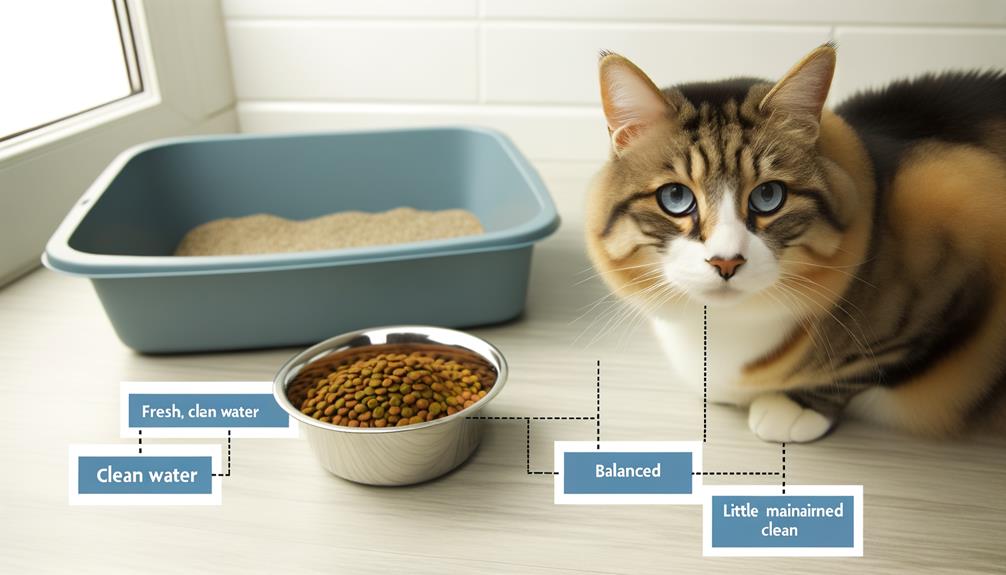
Now that you're equipped with knowledge on when to seek professional help, let's talk about how you can prevent your cat's vomiting and provide effective care at home.
The first step is understanding the importance of hydration. Just like in humans, hydration is crucial for your cat's health.
- Hydration Importance: Keep fresh water available at all times. Cats need to stay hydrated, especially when they've been vomiting. Dehydration can cause serious health problems, and it can also change vomit coloration.
- Monitor Vomit Coloration: Yellow vomit may indicate bile, which could signify a more serious condition. Don't ignore changes in vomit color.
- Diet Control: Feed your cat small meals throughout the day. A large meal after vomiting could upset their stomach again.
- Quality Rest: Vomiting can be exhausting for your cat. Ensure they've a quiet, comfortable place to rest and recover.
Frequently Asked Questions
Is There a Breed of Cat Thats More Prone to Vomiting Than Others?
No specific cat breed's more prone to vomiting than others. It's not about the breed, but individual health, diet, and genetic factors. If your cat's vomiting regularly, consider changing their diet or consult a vet.
Can Certain Medications Cause My Cat to Vomit Yellow?
Yes, certain medications can cause your cat to vomit yellow. It's crucial to consider dietary influences and appropriate vomiting treatments. Always consult your vet before administering any new medication to your feline friend.
Is There a Relationship Between My Cats Age and Frequency of Vomiting?
Yes, your cat's age can influence vomiting frequency. Older cats may vomit more due to diet changes and less hydration. It's important to monitor their diet and ensure they're adequately hydrated to reduce vomiting incidents.
How Do Indoor Cats and Outdoor Cats Differ in Vomiting Frequency or Color?
Indoor and outdoor cats may differ in vomiting frequency or color due to diet influences and hydration status. Outdoor cats may vomit more due to varied diets, while indoor cats might show dehydration through vomit color.
Can a Change in My Cats Lifestyle or Routine Trigger Yellow Vomiting?
Yes, changes in your cat's lifestyle or routine can indeed trigger yellow vomiting. Dietary influences, like a new food, or emotional stressors, such as a move, can cause this symptom. Always consult a vet for advice.
Conclusion
So, it's crucial to pay attention if your cat's throwing up yellow vomit. It could indicate problems like liver issues, dietary concerns, or dehydration.
Don't ignore frequent vomiting – it can pose serious health risks. Always consult your vet if you're worried.
And remember, prevention is the best medicine. Keep an eye on your cat's diet, make sure they're hydrated, and maintain regular vet check-ups. Your cat's health is worth it.

